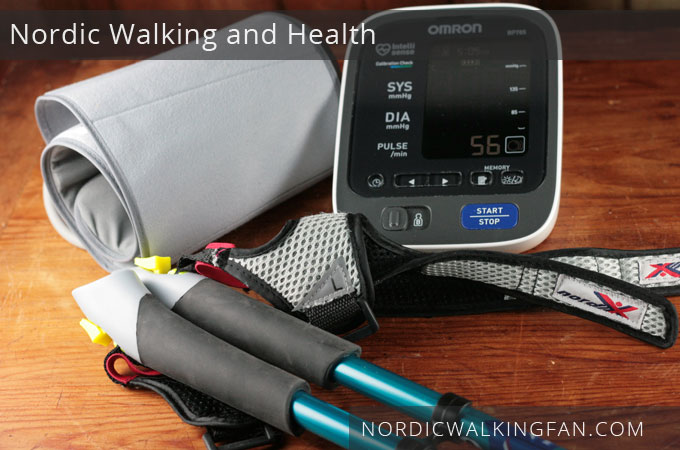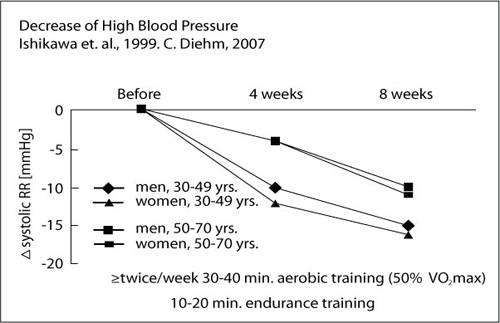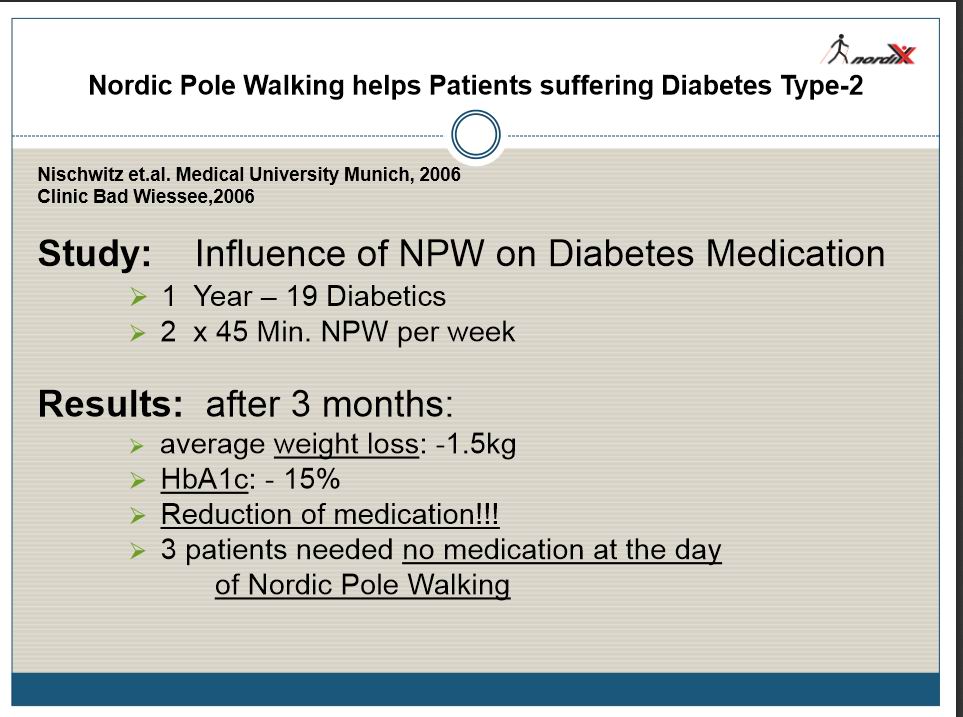Nordic walking has health benefits in common with other forms of exercise walking, with or without poles. However, the actual poles and techniques used in Nordic walking seem to bring together a unique combination of benefits, and act as a prism magnifying the overall health benefits.
Only a relatively small number of studies to date have been done on Nordic walking, as it is a brand new activity dating officially only from 1997.
None of the following should be construed as health advice for you. The following should be regarded as an amateur, cursory overview of some of the literature to be reviewed by you and your health care providers and / or personal fitness consultants.
_________________________________________________
The sport of Nordic Walking involves exaggerated swinging of legs and arms — somewhat like a soldier marching combined with skiing — and so consequently involves 90% of your body muscles. Aside from the obvious lower body impact, it also improves muscles in the upper body including stomach and back muscles, and improves mobility of neck and shoulders. (((Zurawik. Instructor training.))
People talk about feeling their muscles, lower and upper body, returning, and the spring coming back to their step. (( Clay. Nordic Walking for Weight Loss. Testimonials. Retrieved January 2014 from http://www.skiwalking.com/testimonials.asp ))
There are some indications that the exertion compares to jogging: “Among healthy people, Nordic walking was shown to be a more intense workout than normal walking at the same speed; peak heart rate and oxygen consumption … were significantly higher during Nordic walking, greater than even during jogging.” (( Gage. ))
Despite the high exertion, it doesn’t seem like you are working that hard: “Importantly, ratings of perceived exertion were lower for Nordic walking, compared with over-ground walking. This means that during Nordic walking the people in the study reported that it felt like they weren’t working as hard – that the exercise was easier, even though their bodies were working just as hard. They were getting the same health benefit, but the exercise didn’t feel as difficult.” (( Gage. ))
As an aerobic activity of moderate-intensity, Nordic walking can / may (in common with other such activities) reduce risk of chronic illnesses such asthma, some cancers, heart disease, stroke and type 2 diabetes. (( NHS ))
Nordic walking can be practised at three levels: (( Zurawik. Instructor training. ))
- general health to promote weight loss;
- promote endurance and strength;
- promote muscular endurance for physical activities such as running and jumping.
Even though the activity is still less than officially 20 years old (since 1997), organizations and governments in Europe have already recognized its efficaciousness : “In Switzerland, two health insurance firms offer policyholders financial bonuses if they attend Nordic walking courses (Jamie Doward 2005) . In Germany, with an estimated 2 million participants, the government refunds the cost of attending a certified course for hospital outpatients.” ((Zurawik. History.))
“In 2002 the Cooper Institute, Dallas published a research sponsored by Exel which compared physiological responses of Nordic Walking to regular walking. According to the research, Nordic Walking increases oxygen consumption by an average of 20%, with some tests this is up to 46 per cent, and the heart rate increase with about 10 beats per minute when using the Exel Nordic Walker poles (ANWA 2013). Furthermore, the research stated that “The use of Nordic Walker poles is particularly promising, as the poles provide stability that may promote physical activity among older individuals and those with orthopaedic and balance concerns” (ANWA 2013). (( Zurawik. History. ))
“The current analysis revealed that with regard to short- and long-term effects on heart rate, oxygen consumption, quality of life, and other measures, Nordic walking is superior to brisk walking without poles and in some endpoints to jogging. Nordic walking exerts beneficial effects on resting heart rate, blood pressure, exercise capacity, maximal oxygen consumption, and quality of life in patients with various diseases and can thus be recommended to a wide range of people as primary and secondary prevention.” (( Tschentscher M1, Niederseer D, Niebauer J. Health benefits of Nordic walking: a systematic review. Am J Prev Med. 2013 Jan;44(1):76-84. doi: 10.1016/j.amepre.2012.09.043. The analysis involved 27 studies looking at 1900 people. ))
The National Health Service in Britain now also promotes Nordic walking: see their publication on Nordic walking (link valid as of January 2014.)
Recommended practice time for people 19 years and over is 150 minutes a week. (( NHS ))
Joints
Thoughts vary on the topic of Nordic walking and joints.
Some say that Nordic walking is very easy on the joints, because the poles help take some strain off knees and lower body joints, contributing to making you feel lighter.
Some researchers maintain that about 20 percent of the body weight is distributed to the Nordic walking poles. (( Tensoval ))
The British NHS commends it as an activity that is easy on the joints for “those with joint conditions or who may be carrying some extra body weight.” (( NHS ))
Some academics disagree about joint benefits, however. “Biomechanical studies have shown that Nordic walking does not reduce the loading and forces on the knee joint, as some people have thought it would. Nevertheless, Nordic walking appears to improve balance.” (( Gage ))
Blood Pressure
All findings so far seem to agree that Nordic walking is good for reducing blood pressure. Longitudinal analysis is further documenting blood pressure reduction results. ((“On final measurement, three variables, i.e. pulse rate at rest – HRR (E = 73.42 vs. C = 79.68), systolic blood pressure – BPS (E = 118.42 vs. C = 123.65) and diastolic blood pressure – BPD (E = 79.04 vs. C = 83.54), showed lower results in experimental group compared with control group.” — Mikalacki M1, Cokorilo N, Katić R. Effect of nordic walking on functional ability and blood pressure in elderly women. Coll Antropol. 2011 Sep;35(3):889-94. http://www.ncbi.nlm.nih.gov/pubmed/22053573))
How it works, apparently, is that Nordic walking increases the heart size and strength, which improves blood circulation, which lowers blood pressure. Consequently, fewer heartbearts are needed, so it reduces strain on the heart. The leg exercise helps activate the leg muscle pump, thereby helping prevent venous disorders and blood stasis in the legs. (( Tensoval ))
Within a few weeks, positive results should be noticed. In many instances, medication requirements may be reduced in consultation with doctors. (( Nordixx Canada. Decreases blood pressure. Retrieved January 2014 from http://www.nordixx.com/your-health-benefits/disease-management/decrease-blood-pressure/ ))
Diabetes
There is also some evidence that Nordic walking may help some people with diabetes. ((Dr. Klaus Schwanbeck. Nordic Pole Walking and Fall Prevention. Slide Presentation.
Retrieved January 2014 from http://docs.communityconnection.net/Falls%20Docs/End%20of%20Falls%20Presentations/NordicPoleWalking.pdf )) People interested in this topic should consult their doctor and the literature more widely.
_________________________________________________
Sources
Gage, William H. Associate Dean, Research & Innovation, York University. Nordic walking to improve your health. On Don’t Fall web blog. 3 October 2013. Retrieved January 2014 from http://dontfall.ca/nordic-walking-to-improve-your-health/
National Health Service (NHS). Nordic Walking. 11 July 2013. Retrieved January 2014 from http://www.nhs.uk/Livewell/fitness/Pages/nordic-walking.aspx
Tensoval. Nordic walking with hypertension. Retrieved January 2014 from http://tensoval.com/nordic-walking.php
Zurawik, Marta Anna. History of Nordic walking in Finland. Centre for Research for Health and Well-being, University of Bolton. Retrieved January 2014 from http://www.academia.edu/2969365/History_of_Nordic_walking_in_Finland.
Zurawik, Marta Anna. Nordic walking instructor training in Great Britain and Poland- case studies. Journal of Health Sciences 3(11):421-434. 20 December 2013. https://www.academia.edu/5968240/Nordic_walking_instructor_training_in_Great_Britain_and_Poland-_case_studies (link valid as of January 2014



Leave a Reply